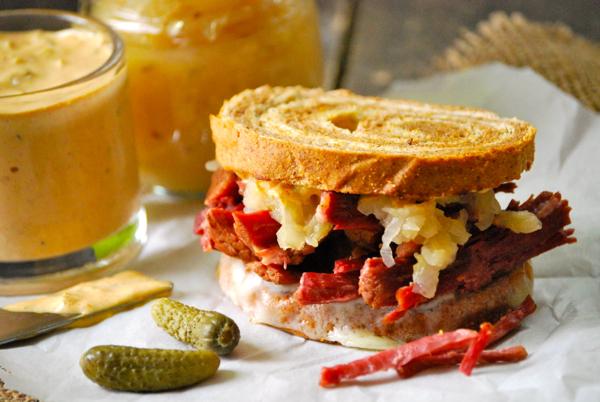Even though St. Patrick’s Day is half a year away, I’m going to try to convince you to make your own corned beef.
The word “corned” was originally a term used for the word grain or kernel. It refers to curing beef with “grains” of salt. We eat this dish every couple of months. It’s so good that I can’t possibly make it just once a year in celebration of my husband’s (very minimal) Irish heritage. And for the record, this version is the best corned beef I’ve ever tasted. Full stop.
 Making corned beef is so simple it’s almost silly. Gather some spices, brine the beef for five days, boil, and eat. That’s it. And yes, you read correctly, you boil the beef. I know, weird. That was my reaction, too. When I first made this dish, I thought that there was really no way I was going to ruin a beautiful five-pound piece of farm-raised beef by boiling it. However, the more I read, I knew I had to give it a try. The result is a succulent, tender piece of meat, with that perfect “corned-beef” flavor.
Making corned beef is so simple it’s almost silly. Gather some spices, brine the beef for five days, boil, and eat. That’s it. And yes, you read correctly, you boil the beef. I know, weird. That was my reaction, too. When I first made this dish, I thought that there was really no way I was going to ruin a beautiful five-pound piece of farm-raised beef by boiling it. However, the more I read, I knew I had to give it a try. The result is a succulent, tender piece of meat, with that perfect “corned-beef” flavor.
Indulge me for a moment while I talk about buying ingredients. You should always use the best quality meat you can find. And by best, I don’t mean most expensive. I’m talking about buying from a reputable producer. Buy it from the farmer’s market, co-op, or your local butcher. Avoid mass-retail supermarket beef that has been raised in crammed cattle yards, corn-fed, and pumped full of antibiotics. Not all meat is created equal. I can’t stress enough how strongly I feel about this. I do my best to minimize our food chain by buying meats, cheeses, milk, and vegetables from folks that I’ve developed relationships with. I want to know where my food comes from, and how it was raised. You’ll find that even the cheapest chuck roast from your farmer’s market will give you spectacular results, and be healthier for your family. Now I’ll step down off of this soapbox.

Aside from the quality of the meat, the spices really make this corned beef stand out. I decided to mix my own pickling spices. I toasted and ground several, which really heightened their flavor. Trust me, it makes a difference, because toasting spices really helps them come to life. Pre-packaged pickling spice, though not necessarily a bad option, doesn’t have the same effect. If you find you’re missing a few that this recipe calls for, Penzeys is an excellent place to order good-quality spices (and dried herbs). They even have a high-quality pickling spice blend if you’re not interested in making your own. If you do make your own, you’ll have some extra to add to other dishes. Put it in this soup, and you’ll be happy.
Now to the interesting part of this recipe. You’ll need to track down some sodium nitrate, more commonly called “pink salt." This is not to be confused with a type of pink salt that can be sprinkled on top of your food. Sodium nitrate is a preservative used in cured meats. It’s what gives corned beef (and bacon) its deep red color and distinctive flavor. In large amounts, sodium nitrate can be toxic, but it is perfectly safe when used correctly. Michael Ruhlman, whose recipe formed the base of my own, states that he feels it’s important — but not necessary — to use it if you’re concerned about safe-handling.
I researched the heck out of this topic, because you know how I feel about unnecessary chemicals in food (see my lecture, above). The fact is, when I eat bacon, or corned beef from a store or farmer’s market, it usually contains sodium nitrate. And I really wanted to make a corned beef that captured that authentic flavor and coloring. So after all my research, and based on the recommendation of a renowned chef, I decided to give it a go. I purchased my pink salt from Clancy’s in Minneapolis. Most butchers who cure their own meats will have it on hand, or you can order it here. Amazon also sells it, but in larger quantities.
Once you’ve boiled your beef, you can use that same brine to boil the potatoes and cabbage, if you’re making those too. It gives them an incredible flavor. Aside from eating the corned beef with potatoes and cabbage, you can make amazing sandwiches too. I probably went a little overboard when I made my own sauerkraut, then baked a loaf of marbled-rye, and whipped up some homemade thousand island dressing. It was so worth it. Hope you enjoy!

Homemade Corned Beef
1 1/2 cups Diamond Crystal kosher salt
1/2 cup granulated sugar
4 teaspoons sodium nitrate (pink salt)
3 cloves garlic
4 tablespoons pickling spice
1 – 5 pound beef chuck roast or brisket
1 medium onion, peeled and quartered
2 celery stalks, roughly chopped
For the Pickling Spice:
2 tablespoons black peppercorns
1 tablespoon yellow mustard seeds
1 tablespoon brown mustard seeds
2 tablespoons coriander seeds
2 tablespoons hot pepper flakes
2 tablespoons allspice berries
1 tablespoon ground mace
2 small cinnamon sticks, broken into pieces
4 dried bay leaves, broken into pieces
2 tablespoons whole cloves
1 tablespoon ground ginger
To make the pickling spice: Combine the peppercorns, mustard seeds, and coriander seeds in a small dry pan. Toast over medium heat until they are very fragrant, being careful not to burn them. Have a lid at the ready, as they may start to “pop." Use a mortar and pestle (or be creative with a rolling pin or side of a chef’s knife) and pulverize the seeds. Combine with other spices. Store in a sealed container, as you will have extra.
To make the corned beef: In a pot large enough to hold the beef, combine 1 gallon of water with the kosher salt, sugar, sodium nitrate (if using), garlic and 2 tablespoons of the pickling spice. Bring to a simmer, stirring until the salt and sugar have dissolved. Remove from heat and let cool until it is room temperature, then refrigerate (or place outside, if you live in a cold climate!) until chilled.
Once the brine is cold, place the beef into it. Place a plate on top of it to keep it submerged, then cover. Refrigerate for 5 days. When the time comes, remove the beef from the brine and rinse thoroughly. Dump out the contents of the pot, give it a wash with soap and water, and place the beef back inside along with the onion, celery, and 2 tablespoons of pickling spice. Fill with just enough water to cover it. Bring to a boil, then reduce heat to low-medium, and cover. Simmer gently for about 3 1/2 hours. Check it near the end, as it may take a bit longer, or may need less time. The meat will be fork-tender and practically fall apart. If it isn’t quite like this, keep cooking it, and it will soon get there.
This can be made ahead of time and refrigerated for several days in the cooking liquid. Reheat in the liquid, or served chilled. The liquid can be used to boil potatoes and cabbage, if making. Enjoy!
Source: Adapted from Michael Ruhlman’s Charcuterie: The Craft of Salting, Smoking, and Curing
 Laurie Jesch-Kulseth is a lifelong home cook who has always believed that eating healthy food is an important part of a balanced life. A wife and mother of two, she pours her heart into the meals she makes for her family. She photographs and writes about it all on her blog, Relishing It, where a version of this story first appeared.
Laurie Jesch-Kulseth is a lifelong home cook who has always believed that eating healthy food is an important part of a balanced life. A wife and mother of two, she pours her heart into the meals she makes for her family. She photographs and writes about it all on her blog, Relishing It, where a version of this story first appeared.
